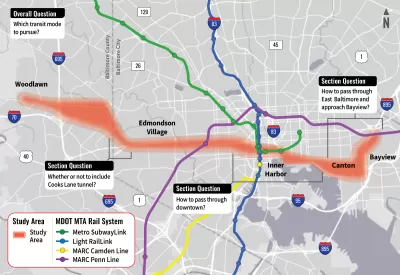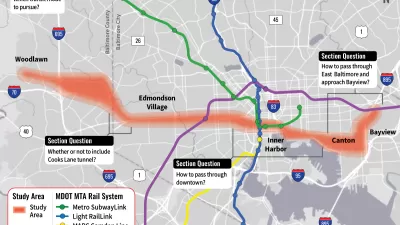The long-awaited east-west transit line is moving forward with support from a new governor, but still has a long road ahead.

Last week, Maryland Governor Wes Moore announced the return of the Red Line to Baltimore, but the announcement left many logistical questions open, writes Alex Holt in Greater Greater Washington. “Which mode would a new Red Line take? Will it include tunnels when entering Baltimore City and passing through Downtown and Harbor East? How much will the project cost? How much of the original plans are still usable, when exactly construction will start, and how long it will take?”
The details released so far, Holt writes, “reinforce how monumental the Red Line’s return is to the future of Baltimore transit.” Holt notes that the route, while still in development, closely follows the original plan, and that heavy rail as an option looks “increasingly unlikely” due in part to the high cost. Meanwhile, bus rapid transit (BRT) is “a definite maybe” and would likely offer the most cost-effective and efficient option.
“The biggest next steps for the Red Line are (1) applying for entry next year into the federal Capital Investment Grants Program and (2) updating the project’s 2012 environmental impact statement (EIS) which was approved by the federal government in 2013.” In any case, the line won’t begin construction until at least 2026, but the MTA will begin testing Red Line-related improvements with a new bus pilot between the North Bend Loop and the Essex Park-and-Ride on August 27.
FULL STORY: Red Line redemption: What Governor Moore’s announcement means for Baltimore

Alabama: Trump Terminates Settlements for Black Communities Harmed By Raw Sewage
Trump deemed the landmark civil rights agreement “illegal DEI and environmental justice policy.”

Planetizen Federal Action Tracker
A weekly monitor of how Trump’s orders and actions are impacting planners and planning in America.

The 120 Year Old Tiny Home Villages That Sheltered San Francisco’s Earthquake Refugees
More than a century ago, San Francisco mobilized to house thousands of residents displaced by the 1906 earthquake. Could their strategy offer a model for the present?

Housing Vouchers as a Key Piece of Houston’s Housing Strategy
The Houston Housing Authority supports 19,000 households through the housing voucher program.

Rural Population Grew Again in 2024
Americans continued to move to smaller towns and cities, resulting in a fourth straight year of growth in rural areas.

Safe Streets Grants: What to Know
This year’s round of Safe Streets for All grant criteria come with some changes.
Urban Design for Planners 1: Software Tools
This six-course series explores essential urban design concepts using open source software and equips planners with the tools they need to participate fully in the urban design process.
Planning for Universal Design
Learn the tools for implementing Universal Design in planning regulations.
Clanton & Associates, Inc.
Jessamine County Fiscal Court
Institute for Housing and Urban Development Studies (IHS)
City of Grandview
Harvard GSD Executive Education
Toledo-Lucas County Plan Commissions
Salt Lake City
NYU Wagner Graduate School of Public Service





























